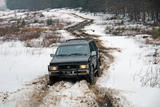craig
Supporting Sponsor, Overland Certified OC0018
Geographers study how *place* affects things. Cultural geographers might notice how there were Plank Houses in the Western PNW where cedar trees are plentiful, igloos in the north where there is snow, and Adobe in the Southwest where clay/straw is plentiful.
People often ask/answer questions about gear and vehicle modifications w/o talking about the physical geography of the area where they will be on expedition. I thought it might be fun to share how our region affects how we setup our vehicles and camping gear.
For example, in the PNW our trails tend to be slippery and off camber so you don't see alot of guys carrying a lot of stuff on their roof. We have plenty of streams around so we carry water purifiers instead of jerry cans. We carry chainsaws because treefalls are common, and Gore-Tex raingear is practically a requirement.
How does your region affect the gear you carry?
People often ask/answer questions about gear and vehicle modifications w/o talking about the physical geography of the area where they will be on expedition. I thought it might be fun to share how our region affects how we setup our vehicles and camping gear.
For example, in the PNW our trails tend to be slippery and off camber so you don't see alot of guys carrying a lot of stuff on their roof. We have plenty of streams around so we carry water purifiers instead of jerry cans. We carry chainsaws because treefalls are common, and Gore-Tex raingear is practically a requirement.
How does your region affect the gear you carry?






